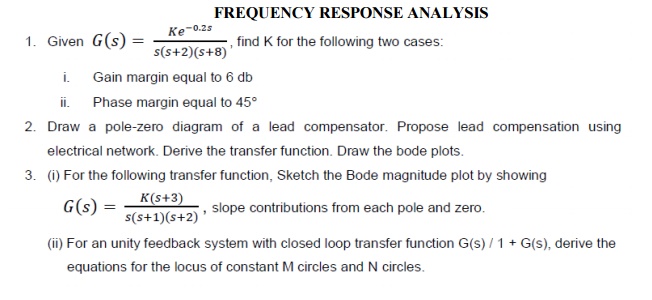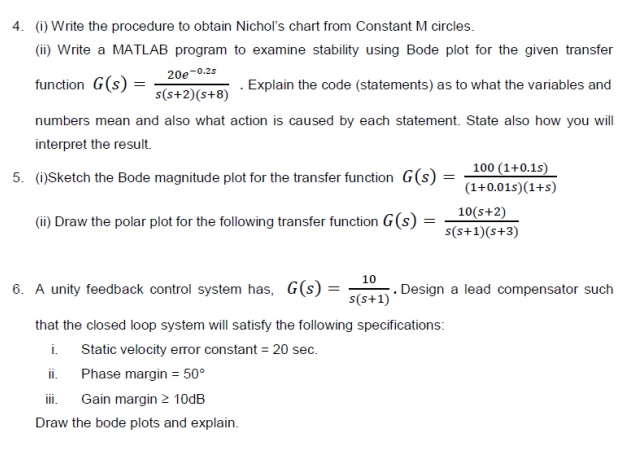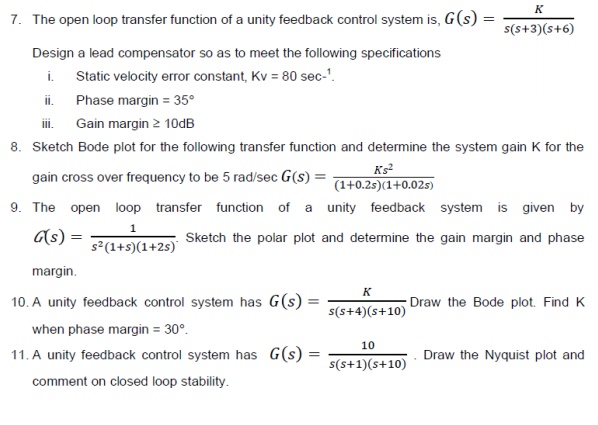Chapter: Control Systems : Frequency Response Analysis
Important Short Questions, Answers, Tutorial Problems: Frequency Response Analysis
FREQUENCY RESPONSE
1.
What is
frequency response?
A
frequency response is the steady state response of a system when the input to
the system is a sinusoidal signal.
2.
List out
the different frequency domain specifications?
The
frequency domain specifications are
Resonant
peak.
Resonant
frequency.
Bandwidth
Cut-off
rate
Gain
margin
Phase
margin
3.
Define
–resonant Peak
The
maximum value of the magnitude of closed loop transfer function is called
resonant
4.
What is
bandwidth?
The
bandwidth is the range of frequencies for which the system gain Is more than 3
dB. The bandwidth is a measure of the ability of a feedback system to reproduce
the input signal ,noise rejection characteristics and rise time.
5.
Define
Cut-off rate?
The slope
of the log-magnitude curve near the cut-off is called cut-off rate. The cut-off
rate indicates the ability to distinguish the signal from noise.
6.
Define
–Gain Margin?
The gain margin, kg is defined as the reciprocal of the magnitude of the open loop transfer function at phase cross over G(jω frequency. Gain margin kg
7. Define Phase cross over?
The frequency at which, the phase of open loop
transfer functions is 180° is called phase cross over frequency ωpc.
8. What is phase margin?
It is the amount of phase lag at the gain cross The phase margin ,γ over frequency required to bring system to the verge of instability.
9. Define Gain cross over?
The gain cross over frequency ωgc is the frequency at which the magnitude of the open loop transfer function is unity..
10. What is Bode plot?
The Bode
plot is the frequency response plot of the transfer function of a system. A
Bode plot consists of two graphs. One is the plot of magnitude of sinusoidal
transfer function versus log ω.The other is a plot of the phase angle of a
sinusoidal function versus log ω.
11. What are the main advantages of Bode plot?
i) Multiplication of magnitude can be in to addition.
ii) A simple method for sketching an approximate log curve is available.
iii) It is based on asymptotic approximation. Such approximation is sufficient if rough information on the frequency response characteristic is needed. is available.
iv) The phase angle curves can be easily drawn if a template for the phase angle curve of 1+ jω
12. Define Corner frequency?
The
frequency at which the two asymptotic meet in a magnitude plot is called corner
frequency.
13. Define Phase lag and phase lead?
A
negative phase angle is called phase lag. A positive phase angle is called
phase lead.
14. What are M circles?
The
magnitude M of closed loop transfer function with unity feedback will be in the
form of circle in complex plane for each constant value of M. The family of
these circles are called M circles.
15. What is Nichols chart?
The chart
consisting if M & N loci in the log magnitude versus phase diagram is
called Nichols chart.
Nichols
chart of M and N contours, superimposed on ordinary graph. The M contours are
the magnitude of closed loop system in decibels and the N contours are the
phase angle locus of closed loop system.
17. What is non-minimum phase transfer function?
A
transfer function which has one or more zeros in the right half S-plane is
known as non-minimal phase transfer function.
18. What are the advantages of Nichols chart?
The
advantages are:
i) It is
used to find the closed loop frequency response from open loop frequency
response.
ii) Frequency
domain specifications can be determined from Nichols chart.
iii) The gain
of the system can be adjusted to satisfy the given specification.
19. What are N circles?
If the
phase of closed loop transfer function with unity feedback is α, then N=tan α.
For each constant value of N, a circle can be drawn in the complex plane. The
family of these circles are called N circles.
The two
types of compensation are
i. Cascade
or series compensation.
ii. Feedback
compensation or parallel compensation.
21. What are the three types of compensators?
The three
types of compensators are
i. Lag
compensator.
ii. Lead
compensator.
iii. Lag-Lead
compensator.
22. What are the uses of lead compensator?
The uses
of lead compensator are
speeds up
the transient response
increases
the margin of stability of a system
increases
the system error constant to a limited extent.
23. What is the use of lag compensator?
The lag
compensator Improve the steady state behavior of a system, while nearly
preserving its transient response.
24. When lag-lead compensator is is required?
The lag
lead compensator is required when both the transient and steady state response of
a system has to be improved
25. What is a compensator?
A device
inserted into the system for the purpose of satisfying the specifications is
called as a compensator.
26. When lag/lead/lag-lead compensation is
employed?
Lag
compensation is employed for a stable system for improvement in steady state
performance. Lead compensation is employed for stable/unstable system for
improvement in transient state performance.
Lag-Lead
compensation is employed for stable/unstable system for improvement in both steady
state and transient state performance
27. What are the effects of adding a zero to a
system?
Adding a
zero to a system results in pronounced early peak to system response thereby
the peak overshoot increases appreciably.



Related Topics